We have at last reached Budapest after several diversions since leaving Debrecen. Even today we got completely side-tracked and only arrived at this little campsite on the outskirts of the city around 6pm.
This morning was spent sorting correspondence and washing the worst of the dirt from Modestine who has become rather grubby lately, caked with squashed flies and mud. So it was 11.30am before we were ready to leave.
We took the pretty, minor road through the green wooded hills to Budapest. It proved to be an excellent choice of route, the twisting road climbing steadily up and over the hills behind Visegrád, through delightful scenery, the roadside a mass of purple and yellow flowers and bright green trees, the dark, more distant hills, completely covered in deciduous woodland. It is a complete contrast here to the Puszta west of Debrecen.
We stopped for lunch at a vendéglö in the little village of Plisszentkereszt. With a name like that it came as no surprise that nobody spoke either English or German so we knowledgeably selected from the Hungarian menu. We did get the chilled, sour cherry soup with whipped cream, and the main dishes were more or less what we expected but it was a disappointment to realise we'd selected chips instead of fried potatoes. (Potatoes are called krumpli.) We'd heard about cold fruit soups and been determined to taste one. Pink, slightly effervescent and containing pepper and pineapple amongst the morello cherries it was very refreshing on such a hot day. The meal was not the best we've had in Hungary and certainly not the cheapest but we felt a sense of achievement at getting by with the language. It's a pity really as we are beginning to build up a considerable vocabulary – certainly Ian is – and it will just be forgotten once we leave the country.
 Chilled cherry soup
Chilled cherry soupWe decided we had enough time to visit the town of Szentendre. The town has a substantial Serbian minority so street signs and menus are often in two languages and restaurants also serve a range of Serbian dishes. Ian visited Szentendre on a library study tour of Hungary many years ago and on our last visit we spent a night in an hotel there, arranged for us by a librarian friend working at the National Library in Budapest. We remembered it as a very pleasant little town full of interesting museums, including the delightful Kovács museum of ceramic art. (Margit Kovács was a highly skilled potter from Szentedre who produced large, idealised, rather whimsical pottery figures back in the 1930s. Her work has since received high acclaim in Hungary.)
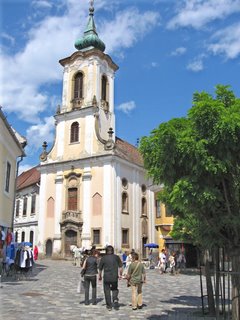 Serbian church, Szentendre
Serbian church, Szentendre A corner of the main square, Szentendre
A corner of the main square, Szentendre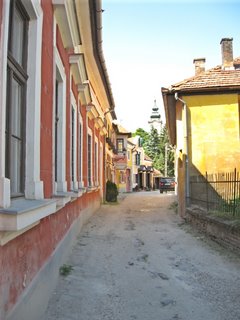 Back street in Szentendre
Back street in SzentendreToday we were surprised to find the little cobbled streets crowded with tourists and to hear English being spoken around us. We are definitely back on the tourist trail. The town is still pretty but full of overpriced souvenir shops selling the usual embroidered linen, painted plates and Russian dolls. None of it is to our taste. Where have all the lovely ceramic folk art products of the communist days gone? We did discover an indigo dyer's shop selling only blue-dyed material with tiny white pinpricks of patterns. These really are hand-dyed using traditional methods and the product was more to our taste. However, we already have a substantial piece of indigo fabric at home purchased by Ian during his study visit.
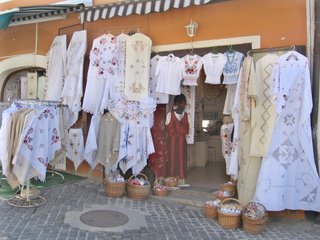 Hand embroidered Hungarian textiles, Szentendre
Hand embroidered Hungarian textiles, Szentendre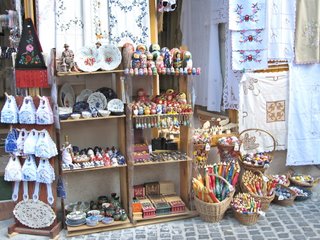 Tourist nick-nacks, Szentendre
Tourist nick-nacks, Szentendre Traditional indigo dyer, Szentendre
Traditional indigo dyer, Szentendre Pattern blocks, indigo dyer, Szentendre
Pattern blocks, indigo dyer, Szentendre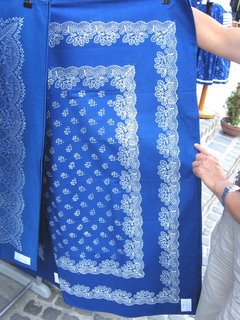 Indigo dyed table cloth, Szentendre
Indigo dyed table cloth, SzentendreAfter a coffee at a shop specialising in the production of marzipan roses and animals, with the usual museum attached, we returned to the banks of the Danube where we had left Modestine in the safe care of a parking attendant. From here it is possible to take the boat down the river to Budapest but it is a rather expensive and touristy thing to do and we needed to find a campsite. Our map showed a site north of the Roman town of Aquincum. After several diversions to avoid roadworks we eventually found it and it seems really pleasant. There are only two camping cars and a tent here but buses and trains run regularly into the centre of the city so we will be able to leave Modestine here tomorrow. As yesterday, we were hot and sticky on arrival and enjoyed wonderful showers immediately. The young man on duty at the site is fascinated with Modestine and is very friendly and helpful with his strange mixture of Hungarian, English and German. This evening the thunder and rain are back, a natural consequence of such a hot, close day. Between downpours we went out in search of a phone box and have now made contact with a couple of old school friends of our Exeter Hungarian friend Kati Vámos. She had warned them we were in Hungary and they had valiantly, possibly unwisely, offered to be on standby should we need assistance of any sort while we are here. They both sounded so friendly on the phone and we have arranged to meet them in Budapest on Friday afternoon. They will carry roses (marzipan or real?) and we will have our Hungarian phrasebook so hopefully we will recognise each other!
Thursday 15th June 2006 Budapest, Hungary
This campsite has one major problem – mosquitoes. We have been bitten and stung, even through clothing. We have various expensive commercial repellents and an electric mosquito coil we acquired in Crete, but the beasties seem unable to understand the Greek instructions and refuse to be repelled. The most effective deterrent, and certainly the most soothing antidote, is Tiger Balm, a present from our daughter Kate who claims it cures anything and constituted her entire medicine cabinet while she was travelling around India. Even these mosquitoes are hesitant to invade Modestine's interior once we have plastered our itching arms and feet with potent smelling orange balm! Ian's just splatted a couple who were unaware this is a no-go zone for insects and they spurted blood – probably Ian's!
This morning we walked to the station to catch the train down to Budapest. We were supposed to buy tickets from a machine on the platform where the instructions were written in Hungarian and beyond our comprehension. Yesterday we'd extracted money from our bank account at a hole in the wall and been issued with two 20,000 forint notes- about £60 each. The train tickets cost 180 forints each – about 50 pence - so we definitely had a problem. We changed the note by buying a huge bag of cheesy potato scones from a kiosk on the platform, only to discover the ticket machine was now being serviced and the train was about to leave! A couple of tickets were thrust into our hands by the repair man who couldn't be bothered to take the money and we jumped on the train as it moved off. Jill tripped on the step, the scone bag bust and scones flew in every direction as Jill sat on the floor of the train nursing a massive bruise on the shin the size of an egg and filling with blood! Eventually we found an unburst bag and decanted scones which were returned from under surrounding seats by helpful passengers. We have been really lucky as the bruising and swelling look very bad but the pain and inconvenience have been relatively minimal. So worried were we that we forgot to compost our tickets – a system where passengers clip their own tickets on trains and buses. So we've had a free day out as we used the tickets on the way back instead.
 This is becoming an obsession! Budapest
This is becoming an obsession! BudapestOnce in the city we climbed the hill on the Buda side of the river up to the Mátyas Templom and the Fishermen's Bastion with its stunning views down on to the Danube with its famous bridges and the Parliament buildings on the Pest side. Of course the area was swarming with tourists and souvenir vendors. This area is to Budapest what Montmartre is to Paris.
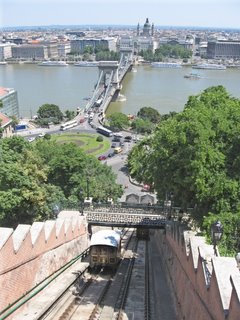 Széchenyi Bridge and cliff railway, Budapest
Széchenyi Bridge and cliff railway, Budapest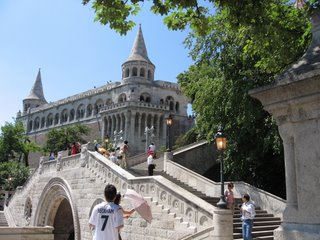 Fishermen's Bastion, Budapest
Fishermen's Bastion, Budapest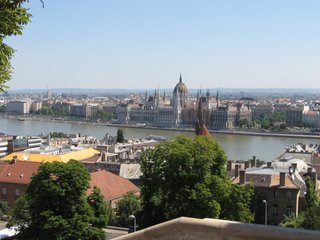 Parliament Buildings from Fishermen's Bastion, Budapest
Parliament Buildings from Fishermen's Bastion, Budapest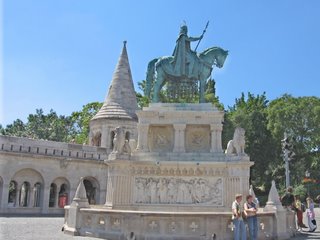 St Stephen, Fishermen's Bastion, Budapest
St Stephen, Fishermen's Bastion, BudapestThe sun has been unpleasantly hot all day but this morning, up here on the bastion there was the slightest of breezes to make it bearable. We visited the interior of the Mátyas church, built in the 13th century, later used as a mosque by the conquering Turks and heavily restored in neo-gothic style between 1784 and 1896. The interior comes as something of a surprise after seeing the delicate gothic tracery and soaring tower from the exterior. Inside all the walls are attractively decorated and painted in a heavy, folk-art style, patterns being integrated with paintings of saints and angels in a style unique to Hungary.
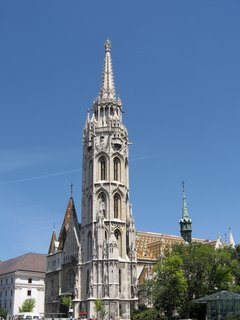 Mátyas Templom, Budapest
Mátyas Templom, Budapest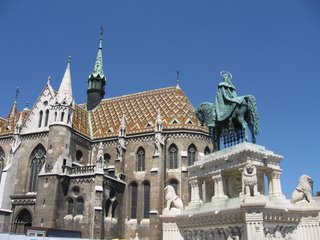 Mátyas Templom, Budapest
Mátyas Templom, Budapest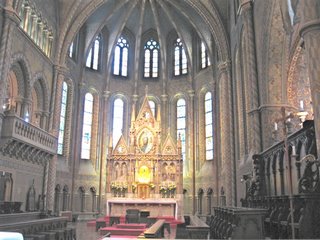 Interior of Mátyas Templom, Budapest
Interior of Mátyas Templom, BudapestThe morning was spent exploring old Buda, visiting the palace gardens and admiring the building of the National Art Gallery from the outside. Unfortunately there is just not time to visit anywhere properly and because of the sticky heat we have not even been able to fully enjoy wandering around seeing the streets and buildings from the outside. Our itinerary today has consisted of simply staying in the shade. Where we ended up was less important than avoiding overheating. The picturesque streets of old Buda provided some welcome relief from the sun and we chanced on Ruszwurm, the famous coffee shop where we had been told to sample poppy-seed retes. The character of the shop seems to have remained unchanged for centuries and certainly the cakes looked quite delicious but the heat was such that we really couldn't face eating cake at lunchtime.
 Eugene of Savoy on the terrace in front of the Palace, Budapest
Eugene of Savoy on the terrace in front of the Palace, Budapest National Library in the Palace, Budapest
National Library in the Palace, Budapest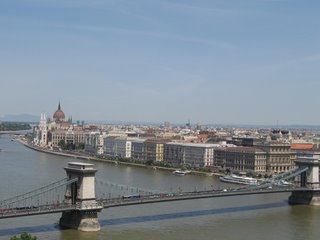 Széchenyi Bridge from Castle Hill, Budapest
Széchenyi Bridge from Castle Hill, BudapestBeing on the Buda side of the river we thought we would take the rack and pinion railway up to the hill at Jánoshegy from where the Children's Railway runs through cool woodland. This used to be a known as the Pioneer Railway in Communist times and was run by children though an adult drove the train. We dragged ourselves across Moszkva tér with its multiple tramlines and walked to where we mistakenly thought the railway started. Seeing us consulting our map a Hungarian man with no knowledge of English asked if he could help. It's quite astonishing how much it is possible to communicate without understanding any of each other's language if you really try and are not intimidated. He explained quite clearly what we needed to know, asked which country we came from and wished us a good time. When he'd gone we gave up our plan as we'd run out of time and enthusiasm and it meant yet another long walk and finding a tram etc.
Restaurant prices are noticeably higher in Budapest than elsewhere in the country. Kati Vámos recently emailed us with details of the best and cheapest places to eat, so we followed her instructions and ended up at a little place near the main market where we had HUGE meals of bean soup and meatballs for Ian and paprika pork and gnocci for Jill. It was delicious but far too much to finish. Telling us where to go was only half the job Káti. How do you ask for what you want when you arrive? It's not the place they expect to find non-Hungarian speaking English pensioners! We did our usual and pointed after watching to see what other people selected.
We always end up walking around in the heat of the day. It's inevitable with the lifestyle we are leading, living on campsites way out of town and needing to see the maximum we can in the few hours we have available. So we walked all the way to Margit Híd and onto Margit's Island in the Danube, full of shady walkways, trees, flower beds, lawns and fountains. It is where families go to escape the heat of the city. Exhausted we settled on the grass beside a huge fountain spurting and cascading water twenty metres or more into the air. It accompanied piped classical music, the pulsing of the water timed to match the crescendo of the music. As it played cool moist air passed over the grateful audience surrounding it.
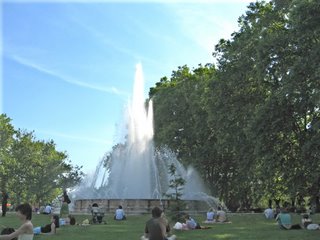 Musical fountain on Margit's Island, Budapest
Musical fountain on Margit's Island, BudapestThe island is surprisingly long and we slowly made our way beneath fruiting mulberry trees to its northern tip where it is linked, by a subterranean passage full of unsightly graffiti to the bridge at Árpád Hid.
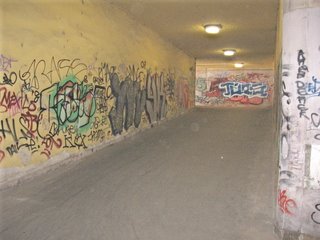 Underpass at Árpád Hid, Budapest
Underpass at Árpád Hid, BudapestFrom here we could walk to the nearest stop on the railway line back to our little campsite at Békásmegyer, which tonight we have completely to ourselves. The immediate area surrounding the station at Békásmegyer is not at all attractive, being a series of high-rise blocks of flats in typical, uninspired communist style with areas of open grassland between the blocks, a few small shops, bars and cafes, an old people's home and a school. There does however seem a sociable, friendly atmosphere amongst neighbours. Today we stopped to join some of them for a couple of water ices at a little stall surrounded by characterless crumbling tower blocks and watched the local residents out with their children. Our impression is that Hungarian children are very well behaved and there is a particularly close bond of affection between parents and children.
On an earlier visit to Budapest we were very critical of the graffiti that is sprayed on so many of the walls in the city. Sadly it seems just as bad now. Underpasses, blocks of flats, railing and bridges, all in the heart of the city, are prime targets. It is difficult to know what can be done. As soon as one lot is removed, it will be replaced. It is an ugly eyesore and completely offensive. Tourists perhaps are driven to the main sights so don't see the subways, but they must cross bridges. As you see here, superb views can be quite ruined by it. Budapest has our vote for graffiti capital of Europe.
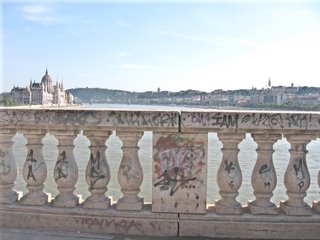 Danube from Margit Bridge, Budapest
Danube from Margit Bridge, BudapestSaturday 17th June 2006 Budapest, Hungary
Life becomes an effort when the weather is so close and so very hot. Yesterday was so difficult that we even gave up trying to keep up with the blog. We are now sitting under a tree in a field full of mosquitoes alternately scratching, typing and splatting as we try to catch-up on yesterday. Impossible to be inside Modestine where the temperature on the mobile phone says it is 32 degrees and rising at 10am!
So to update on Friday 16th… We walked down through the hot streets of this rather drab Budapest suburb of Békásmegyer towards the station. The flats here are an inheritance of the Socialist period, being huge blocks with no balconies or anything to relieve their monotony. The lower levels are all covered in graffiti and the doors and windows in need of repainting. Everywhere you have the impression of a need for security with padlocks on every door. The health clinic and library in the centre of the development are drab and dark and again covered in graffiti. It's such a pity for the people living here – mainly young families who bring up their children in flats without lifts or balconies. Around the blocks are rows of single story lock-up shops and there are open grassy spaces but little shade when walking along the roads.
This is an observation and is not intended to be negative. It is an unfortunate inheritance Hungary needs to rectify eventually but it will still take many years. The corner where we are camping is near the banks of the Danube and apart from the beasties is very pleasant, particularly as we are the only ones here.
We found a little computer repair shop that also provided internet access so loaded up our latest blog before continuing towards the station. Next we discovered a superb covered market which was cool and bursting with wonderful fresh vegetables, fruit, meat and fish. In Britain our markets are so tame compared to the excellent ones we have seen in every country we have visited. It also explains why supermarkets almost everywhere except France are rather drab and uninteresting containing mainly dried stuffs and essentials - soaps, pastas, tinned goods, wines, beers and dried sausages. We greatly enjoyed watching people behind the counters chatting with customers, filleting meat or fish, weighting out all sorts of interesting things we didn't recognise – how we would have loved to know what they were used for and how to prepare the dishes! One of the stalls here sold a Hungarian version of Chinese food and being lunch-time we got out our pointy fingers and enjoyed rice with sweet and sour chicken laced with paprika, with sliced cabbage substituting for water chestnuts and bean sprouts. It was very nice and even with bottles of chilled water cost us less than £2 each!
Eventually we caught the train and arrived in Budapest for the afternoon. The subway at the suburban station here was lined with advertisements placed by people living nearby with items to sells, items required, services to offer etc. Nobody seems to takes them down and there were thousands of them along the walls.
 Small ads in the subway, Békásmegyer, Budapest
Small ads in the subway, Békásmegyer, BudapestIt was suffocating in the city and the metro was not running. Buses and trams were hot and sticky with no shade at the stops so we walked across the river to the Pest side of the city.
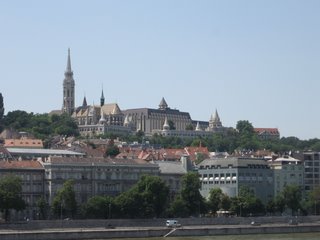 Buda from the Pest side of the river, Budapest
Buda from the Pest side of the river, BudapestSeeking the shade and making slow progress we eventually found our way to the Synagogue, which we have never visited. We have still never visited it as we arrived two minutes before it closed for the Jewish Sabbath and it would have cost us 1200 forints to go in! Fortunately the outside was still visitable and one of the things we wished to see was the remembrance tree in the grounds. This is a stainless steel construction full of silver leaves, each leaf having the name of a Jewish family that had suffered during the Nazi regime. We found it a moving experience seeing so many thousands of leaves gently swaying on the tree and thinking of friends who are survivors and descendents of those families today.
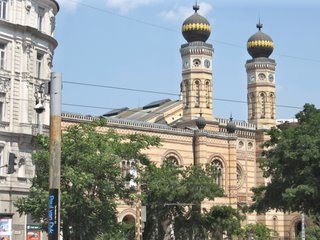 Jewish synagogue, Budapest
Jewish synagogue, Budapest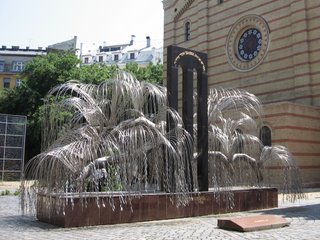 Remembrance tree, Jewish synagogue, Budapest
Remembrance tree, Jewish synagogue, BudapestNearby is the Budapest Opera House, a flamboyant expression of the pride of the city during the late years of the nineteenth century, its balustrade lined with statues of eminent composers. We peeped inside and found it cool and smart with red carpets, bright mirrors, elegant statues and glass chandeliers.
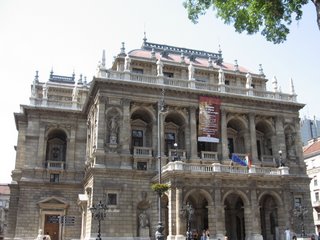 Budapest Opera House
Budapest Opera HouseOur next stop was Budapest cathedral. It may not be as large as Esztergom but it it still impressive and the interior is quite stunning. It must count as the cathedral with the most "bling" we have ever visited! Gold and ornamentation cover every centimetre of its wide, high interior, its dome covered with beautiful glass mosaics constructed in Italy. So well done are they that it was only when we used the binoculars we realised they were not paintings. Best of all, the interior was blessedly cool and dark after the searing heat and sunshine we left at the door. We sat for ages resting and gradually feeling better. To the side of the altar is a small room filled with Japanese tourists taking each other's photo next to the glass reliquary containing the remarkably well preserved hand of St. Istvan – the same one who's head is supposedly in Esztergom cathedral! We found it all a little bizarre both from the reliquary viewpoint and also that the Japanese seem to spend their entire time in Europe having their photos taken in front of things.
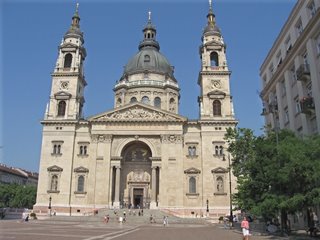 Cathedral of St. Stephen, Budapest
Cathedral of St. Stephen, Budapest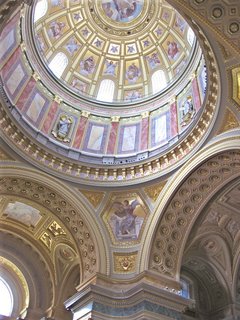 Dome of the Cathedral showing mosaics, Budapest
Dome of the Cathedral showing mosaics, Budapest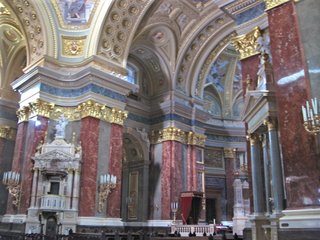 Lots of bling in the Cathedral of St. Stephen, Budapest
Lots of bling in the Cathedral of St. Stephen, Budapest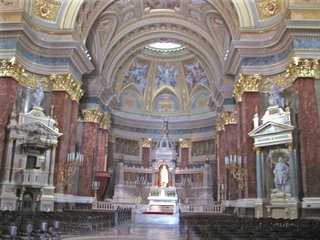 Altar in the Cathedral of St. Stephen, Budapest
Altar in the Cathedral of St. Stephen, Budapest Handy box, Cathedral, Budapest
Handy box, Cathedral, BudapestFeeling much fresher we made our way to the Gerbaud coffee house to meet Kati's friends Sebi, Judit and Zoltan. We waved our Hungarian phrase-book around until they saw it and claimed us. Under the sunshades of this most exclusive of Hungarian coffee shops we chatted for well over an hour and it added a very happy experience to our afternoon. They are old school friends of Kati and there was considerable reminiscing about the friendship that has lasted through so many personal and political changes in their lives. There was also quite a lot of laughter! Thank you all for the trouble you took to welcome us and add such pleasure to our day. Thank you too Kati and Peter for arranging it.
 On the terrace of the Café Gerbaud, Budapest
On the terrace of the Café Gerbaud, Budapest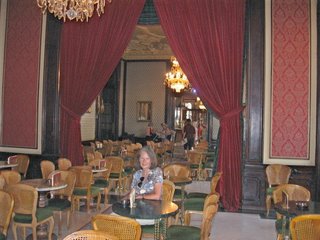 Interior of the Café Gerbaud, Budapest
Interior of the Café Gerbaud, BudapestThe air had cooled with the evening and we walked comfortably around the area, back across the Erzsébet Bridge and along the further bank to the station for the train back to Modestine. It was dark by the time we rejoined her. Having been shut up all day she was stiflingly hot and the field droning with armies of hungry mosquitoes waiting for supper to arrive. Impossible to do anything other than go to the local vendeglo by the river where citronella candles glowed in the dark. They really do work! From the moment the waiter lit one on our table the mosquitoes gave up and left us in peace to apply tiger balm to the bits of our limbs they'd already tasted. The supper was superb, expensive compared to recent prices but unbelievable compared to England. Pork. liver, bacon and onions with salad and potatoes – all cooked in a Hungarian manner very different from what one might expect but delicious - and pike-perch, salad and parsley potatoes. Together with three beers the bill was 4,200 forints - around £12!
There was a big screen football match showing with Hungarian commentary as we waited for our meal. With his expanding command of the language Ian enthusiastically supported England against Mexico though did comment the team didn't really look very English as they were all black. It was some time later when the score was displayed he realised he's been supporting not Angol but Angola!
Modestine was much cooler by the time we returned and we do have an electric fan. Too tired to do anything else we went straight to sleep with the windows wide open – thank heavens for mosquito mesh blinds.
